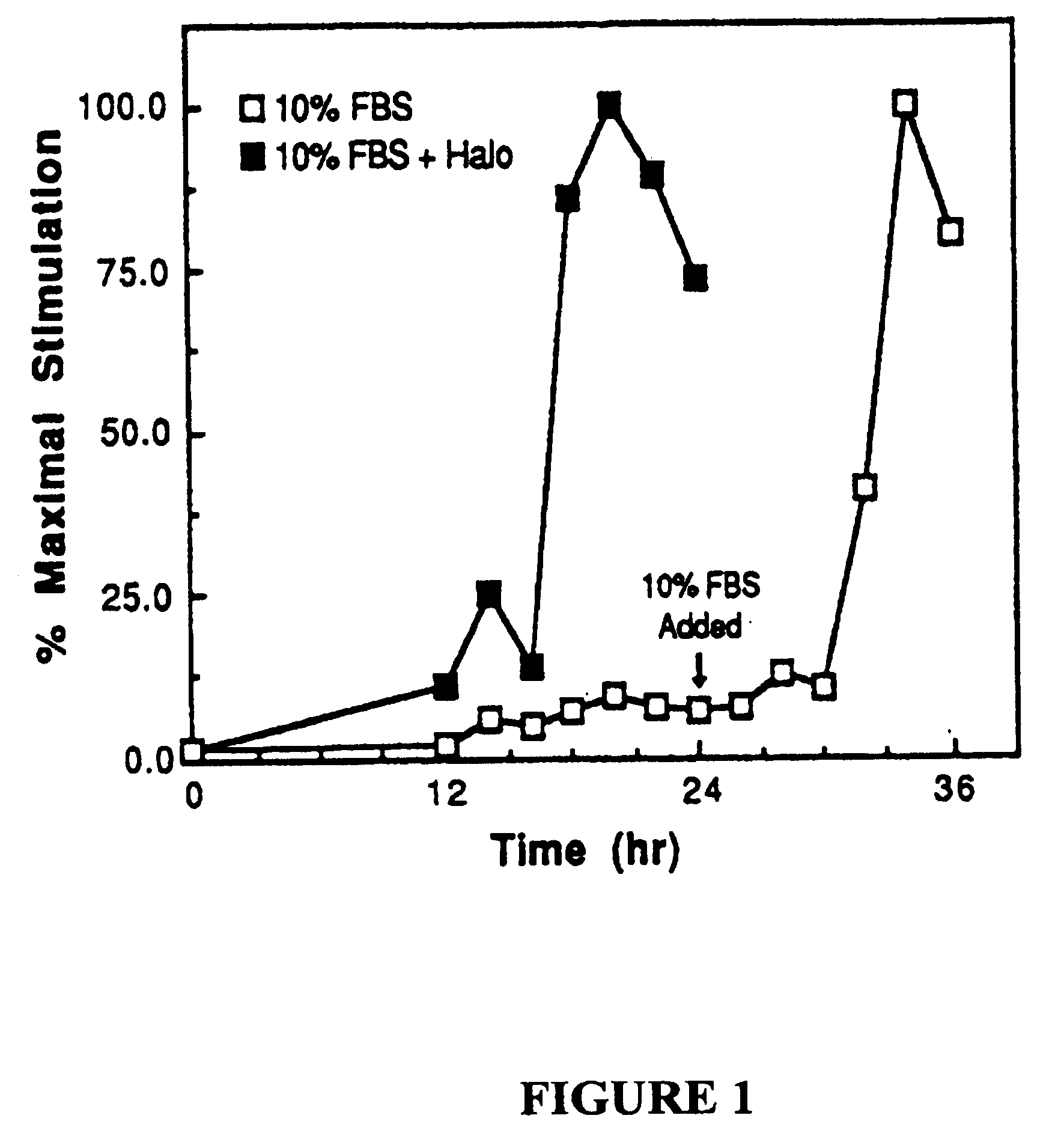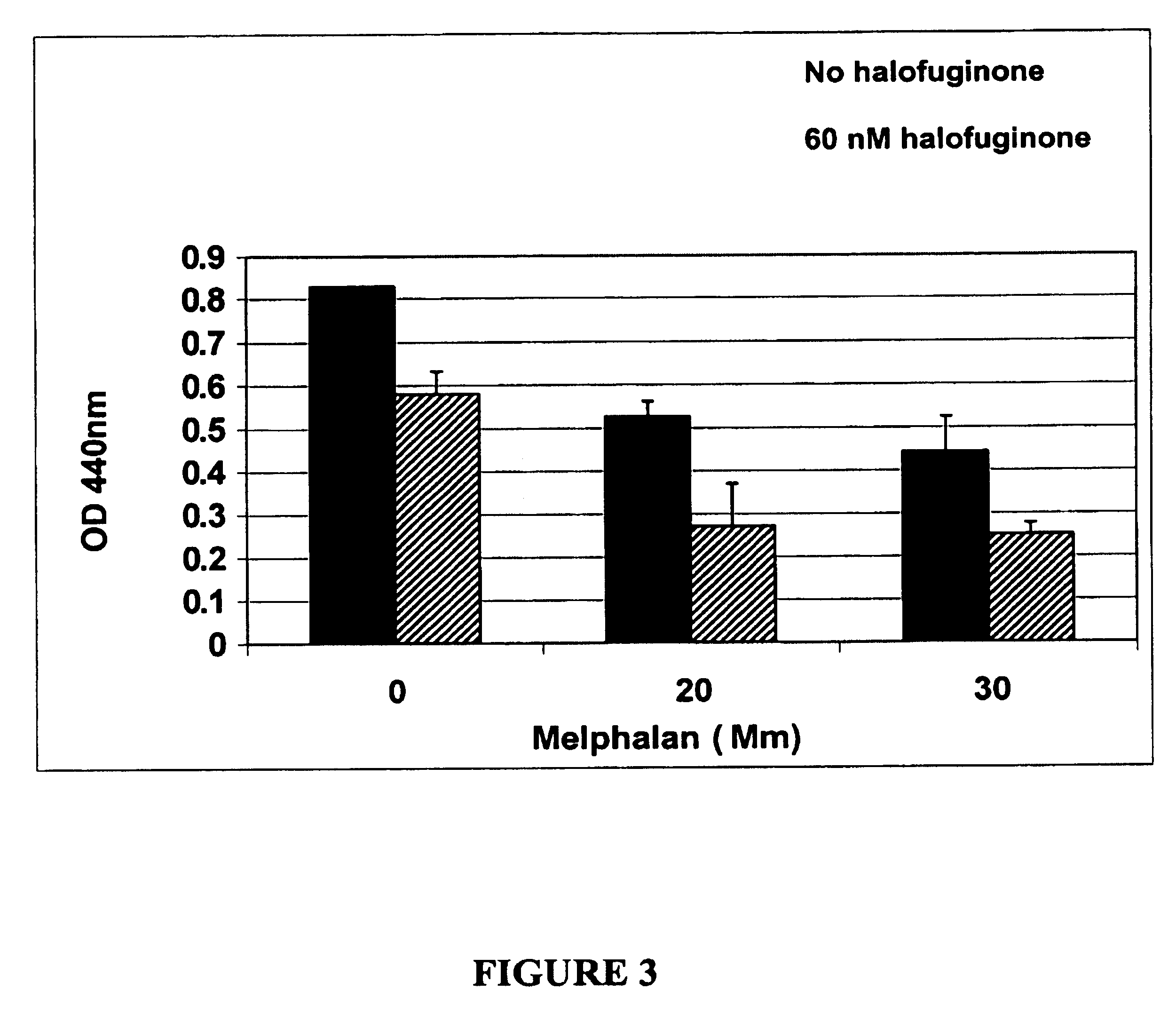Quinazolinone compounds in combined modalities for improved cancer treatment
a combination therapy and quinazolinone technology, applied in the direction of applications, peptide/protein ingredients, drug compositions, etc., can solve the problems of insufficient prevention or curative treatment of radiation fibrosis, the destruction of normal tissue structure and function, and the adverse effect of radiation fibrosis is extremely severe, so as to improve the effectiveness of anti-tumor treatment and increase the sensitivity of tumor cells
- Summary
- Abstract
- Description
- Claims
- Application Information
AI Technical Summary
Benefits of technology
Problems solved by technology
Method used
Image
Examples
example 1
The Effect of Combined Treatment of Halofuginone and 1,3-bis(2-chloroethyl)-1-nitrosourea (BCNU)
[0100] Halofuginone was tested in the human T98G glioblastoma xenograft implanted subcutaneously or intracranially. Mice were implanted with the human T98G glioblastoma tumor cells subcutaneously in a thigh or intracranially.
[0101] Halofuginone was administered orally by gavage at dose levels of 0.1,0.2, and 0.5 mg / kg / day, once per day, on days 4 through 34 days post tumor implantation. Each group contained 5 mice.
[0102] The endpoint for the subcutaneous tumor was tumor growth delay while the endpoint for the intracranial tumor was increase-in-lifespan (survival).
[0103] There was no effect of halofuginone on the body weight of the animals.
TABLE 1Response of the Human T98G Glioblastoma Multiforme to treatmentwith BCNU along with halofiginoneTUMOR GROWTHDELAYSURVIVALTREATMENT GROUPDays (sc tumor)Days (ic tumor)CONTROL064 ± 10No treatmentBCNU (15 mg / kg), ip,3.9 ± 0.497 ± 21days 7, 9, 1...
example 2
Halofuginone Induces Cell Cycle Arrest in Rabbit Aortic Smooth Muscle Cells (SMC)
[0107] Experiments were conducted to determine the specific phase of the cell cycle in which SMC treated with halofuginone were arrested.
[0108] As determined by [3H]-thymidine incorporation, addition of 10% FBS to growth-arrested, quiescent SMC promotes entry of the cells to S phase after a G1 period of 16 hours. Maximal DNA synthesis was seen 20 hours after serum-stimulation (FIG. 1).
[0109] When halofuginone (10−7 M) was added with 10% FBS, only low levels of [3H]-thymidine incorporation were observed (FIG. 1). It was next determined whether halofuginone arrested proliferation at a specific stage in the cell cycle. For these experiments, quiescent SMCs were kept in 10% FBS plus 10−7 M halofuginone for 24 hours. The cultures were then washed and placed in 10% FBS with [3H]-thymidine and without halofuginone. At various times after halofuginone removal, the cells were harvested and thymidine incorpora...
example 3
Halofuginone Arrest Rat Mesangial Cells (RMC) in G0 / G1 Phase
[0111] Further experiments were conducted to determine whether halofuginone arrests mesangial cell proliferation at a specific phase of the cell cycle.
[0112] For this purpose sub confluent RMC's were kept in 10% FCS in the absence or presence of 150 ng / ml halofuginone for 24 hours. The cells were then harvested, stained with propidium iodide and analyzed by FACScan. The percentage of cells progressing into G2 / M phase was reduced by halofuginone from 20% to 7%. The percentage of cells in G0 / G1 was increased from 38% in the absence of halofuginone to 65% in the presence of halofuginone. These results indicate that in the presence of halofuginone, a large proportion of the mesangial cells are arrested in the G0 / G1 phase.
PUM
| Property | Measurement | Unit |
|---|---|---|
| time | aaaaa | aaaaa |
| time | aaaaa | aaaaa |
| pharmaceutical composition | aaaaa | aaaaa |
Abstract
Description
Claims
Application Information
 Login to View More
Login to View More - R&D
- Intellectual Property
- Life Sciences
- Materials
- Tech Scout
- Unparalleled Data Quality
- Higher Quality Content
- 60% Fewer Hallucinations
Browse by: Latest US Patents, China's latest patents, Technical Efficacy Thesaurus, Application Domain, Technology Topic, Popular Technical Reports.
© 2025 PatSnap. All rights reserved.Legal|Privacy policy|Modern Slavery Act Transparency Statement|Sitemap|About US| Contact US: help@patsnap.com



